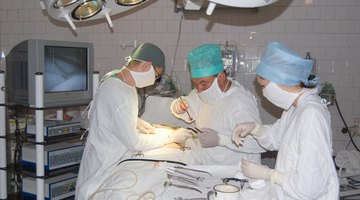Iliac artery occlusion is a potentially life-threatening condition in which partial or complete closure of the iliac arterial system obstructs blood supply to the pelvis, or via the connecting femoral artery to the leg. In addition to causing pain and discomfort, the condition left untreated can lead to tissue death. Because the blockage of the artery can be gradual, symptoms are often hard to detect in the early stages, but can later become severe.
Arterial Occlusive Disease
Arterial occlusion is the closing or blockage of an artery causing an obstruction to blood flow, which is known as "ischemia". Arterial occlusive disease often obstructs blood flow to the legs through the iliac and femoral arteries. Such blockage can be caused by atherosclerosis, a condition in which a build-up of fatty deposits known as "plaques" cause narrowing and ultimately closure of the artery. It can also be caused by thrombus formation, often associated with atherosclerotic disease. A thrombus is a blood clot formed by coagulation of platelets within the artery. A thrombus lodged in an artery can reduce and even completely halt blood flow.
- Arterial occlusion is the closing or blockage of an artery causing an obstruction to blood flow, which is known as "ischemia".
- It can also be caused by thrombus formation, often associated with atherosclerotic disease.
The Iliac Arterial System

The common iliac artery carries blood toward the lower body where it divides into the internal iliac artery, which supplies blood to the pelvis, and into the external iliac artery, which supplies blood to the leg. This is shown in a diagram on page 129 of "Grant's Dissector." The external iliac is a large artery that becomes the femoral artery in the region of the groin. The femoral artery runs the length of the thigh. Obstruction of the external iliac artery blocks blood supply to the femoral artery and thus to the lower limb. The general name for conditions caused by arterial occlusion is peripheral vascular disease.
- The common iliac artery carries blood toward the lower body where it divides into the internal iliac artery, which supplies blood to the pelvis, and into the external iliac artery, which supplies blood to the leg.
- The external iliac is a large artery that becomes the femoral artery in the region of the groin.
Symptoms of Iliac Occlusion
Symptoms of ischemia caused by occlusion of the arteries supplying the lower limb include severe pain and numbness and coldness in the limb. If blood flow is completely cut off, lack of sensation and paralysis can follow. Significant reduction in blood flow also presents as "claudication," a difficulty in walking characterised by muscle tiredness, cramps and aching. In the early stage of occlusion, recovery can be produced by rest.
- Symptoms of ischemia caused by occlusion of the arteries supplying the lower limb include severe pain and numbness and coldness in the limb.
- Significant reduction in blood flow also presents as "claudication," a difficulty in walking characterised by muscle tiredness, cramps and aching.
Onset of Symptoms

Because arteries may narrow slowly and gradually, symptoms are often not present in the early stages of arterial occlusive disease and become pronounced only after some 70 per cent of the blood flow is lost. When the reduction in flow to the leg becomes severe, significant changes are seen, including not only severe pain but dry skin, loss of hair growth, sores and ulcers and—if untreated—gangrene or tissue death, at which point amputation may be necessary. Although onset may be gradual, the condition can worsen suddenly, especially if new blood clots form.
Diagnosis and Treatment
The presence of arterial occlusion can be measured through blood flow tests. Angiography, a minor surgical procedure, is the injection of dye into arteries allowing precise images of narrowing and blockage to be seen. Blockages can be treated through angioplasty, in which a balloon is inflated in the artery to widen the passage for blood flow. Medication is then used to reduce the danger of further clotting. Blood clots can also be directly removed by surgery. In severe cases a bypass around the blocked artery can be created by using a vein from another part of the body, or surgical tubing, to reroute the blood supply.
- The presence of arterial occlusion can be measured through blood flow tests.
- Angiography, a minor surgical procedure, is the injection of dye into arteries allowing precise images of narrowing and blockage to be seen.
